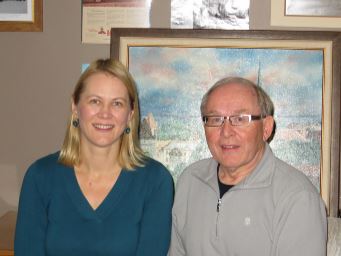Alberta Estonian Heritage Society (Western Canada) – Ten Years Old!
In its 10 years, the Alberta Estonian Heritage Society has blended and achieved.

Alberta Estonian Heritage Society’s third and current president, Ave Peetri, with the second ex-president Bob Kingsep at a Board meeting in Calgary, 2013.
Photo: Helgi Leesment
Spring 2015 marks a decade since the inauguration meeting in Red Deer, Alberta where official government forms were signed to create the AEHS as a registered non-profit organisation and set its purpose. The popularity of the Internet, email, and websites had reached the point where a society could function in a relatively cohesive manner despite having members located hundreds of kilometres apart. Even when the bylaws were updated eight years later, we retained our basic purpose:
• Provide for the recreation of the members and to promote and afford opportunity for friendly and social activities.
• Promote and preserve Estonian heritage and culture in Alberta.
• Facilitate contact and current awareness among persons with an interest in Estonian heritage and culture in Canada, Estonia, and elsewhere.
The inaugural meeting saw the coming together of Albertans of Estonian heritage from different backgrounds, ranging from recent arrivals to descendants of Estonians who migrated from their homes over a century ago. That is the ‘blending’.
There is richness in such blending: people bringing stories and ideas from diverse backgrounds further enrich each other’s knowledge, understanding, and friendship. After all, despite commercial efforts to have us believe that physical possessions equal happiness, it is our relationships with other people that are the basis of happiness and a sense of belonging.
AEHS social functions and major resource achievements have fostered a gentle sense of belonging and perhaps even validated the past where individuals were previously vague in knowledge of their own family history. Albertans of Estonian decent have met others with similar cultural heritage and have become more aware of their own family histories. They were motivated to look for family photos and artefacts, and generously provided these to the AEHS, resulting in a wideranging history website, a half-hour documentary DVD, a 300-page book, a special collection at the Provincial Archives of Alberta, a six-panel display depicting the story of Estonians in Alberta and highly commended issues of AjaKaja magazine, published twice annually. AjaKaja, in particular, is the unique platform for Alberta stories that do not fit other publications; our editors honour this niche well. These remarkable achievements were accomplished in a surprisingly short time span.
But achievements go beyond the electronic, the artefacts, and the hardcopy text. Through these means AEHS has enabled people to create or add to their own family trees and to travel to specific villages and farms in Estonia from where their ancestors came, and to Estonian settlements in Crimea. Some have reconnected with long lost relatives. Through various print media, AEHS has informed Estonians throughout the world of Alberta’s unique Estonian story, something that was generally not known previously. We are providing genealogists, archivists, librarians and other researchers with rich resources. With additional publicity, Albertans beyond AEHS will become better aware of these resources, adding to information about this western Canadian province. We know from attending Baltic Heritage Network international conferences that Australians, North Americans and Europeans are accessing AEHS materials. Thus AEHS’s achievements and blending perfectly complement each other to the benefit of many in Alberta as well as elsewhere.

Alberta Estonian Heritage Society’s Jaanipäev bonfire at Gilby, Alberta with members of Toronto’s Ööbik Choir among the guests. June 2012.
Photo: J. Laansoo
What is next? Perhaps if we take a page from our own accomplishments we will see that the answer lies in ourselves. The first generations of Estonians to Alberta did not set out to make history. But they did. Current generations did not enter this world with a goal to make history, but we are. Enjoying participation in AEHS organised events and recording our personal anecdotes and images, new or old, are some of our options for carrying on the celebration of Estonian culture as we have adapted it in Alberta. To that end, we have adapted to and will continue to adapt to the technology offered by the World Wide Web.
We have the means; we can reach all interests; we can continue to build our heritage.
Helgi Leesment, Calgary, Alberta, with input from Bob Kingsep